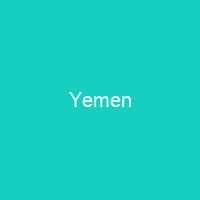Yemen: A Crossroads of Civilizations
Imagine a country that has been at the crossroads of civilizations for over 7,000 years—Yemen. Nestled in West Asia, bordering Saudi Arabia, Oman, and the Red Sea, Yemen is not just a geographical location but a living testament to human history and culture. From ancient times when figures like the Queen of Sheba roamed its lands, to modern-day conflicts that have left it one of the poorest countries in the world, Yemen’s journey is nothing short of fascinating.
Yemen has existed at the crossroads of its civilisations for more than 7,000 years. The country was home to figures such as the Queen of Sheba who brought a caravan of gifts for King Solomon. For centuries, it became a primary producer of coffee exported in the port of Mocha. From its conversion to Islam in the 7th century, Yemen became a center of Islamic learning, and much of its architecture survived until modern times.
The Sabaean Kingdom
One of the most prominent federations was the Sabaean Kingdom (Arabic: سَـبَـأ), thought to be biblical Sheba. The Sabaean rulers adopted the title Mukarrib, generally thought to mean unifier or a priest-king. By the third century BC, Qataban, Hadhramaut, and Ma’in became independent from Saba and established themselves in the Yemeni arena.
The Roman Influence
With its long sea border between eastern and western civilizations, Yemen has long existed at a crossroads of cultures with a strategic location in terms of trade on the west of the Arabian Peninsula. The Romans had a vague and contradictory geographical knowledge about Arabia Felix. A Roman army of 10,000 men was defeated before reaching Marib.
The Rise of Himyarites
After the Roman expedition (perhaps earlier) the country fell into chaos, and two clans, namely Hamdan and Himyar, claimed kingship, assuming the title King of Sheba and Dhu Raydan. Dhu Raydan allied themselves with Aksum in Ethiopia against the Sabaeans.
The Islamic Era
By 515, Himyar became increasingly divided along religious lines and a bitter conflict between different factions paved the way for an Aksumite intervention. The last Himyarite king Ma’adikarib Ya’fur was supported by Aksum against his Jewish rivals.
The Zaydi Imams
By 630, Yemen became an Islamic state under the Rashidun Caliphate. Yemenite tribes played a key role in expanding Islam and contributing to Umayyad rule. The Ziyadid dynasty was founded by Muhammad ibn Abdullah ibn Ziyad around 818. The first Zaidi imam, Yahya ibn al-Husayn, arrived in Yemen in 893 and established the Zaidi imamate in 897.
The Modern Era
Yemen’s modern history is marked by political crises and civil wars. Since 2011, Yemen has been experiencing a severe humanitarian crisis, making it one of the least developed countries in the world and the poorest in the Middle East and North Africa.
The Current Situation
Yemen’s president opposed military intervention in the Kuwait crisis and abstained from UN Security Council resolutions concerning Iraq and Kuwait. After a series of violent incidents, including the USS Cole bombing, Saleh assured President Bush that Yemen was a partner in the War on Terror.
The Economy
Yemen’s economy is one of the poorest in the Middle East, with a GDP of US$61.63 billion and an income per capita of $2,500. The service sector accounts for 61.4% of GDP, followed by industry (30.9%) and agriculture (7.7%). Agriculture produces commodities such as grain, vegetables, fruits, and livestock, with qat cultivation being a major issue.
Water Scarcity
A key challenge is severe water scarcity, especially in the Highlands. Groundwater is the main source of water in Yemen, but the water tables have dropped severely due to lack of regulation. This has left the country without a viable source of water. Before the revolution, experts described Yemen’s water situation as dire.
Culture and Heritage
Yemen is a tribal society with minority groups and hereditary caste groups in urban areas. The Old Walled City of Shibam in Wadi Hadhramaut, inscribed by UNESCO in 1982, is nicknamed ‘Manhattan of the Desert’ because of its skyscrapers. Surrounded by a fortified wall made of mud and straw, the 16th-century city is one of the oldest examples of urban planning based on the principle of vertical construction.
World Heritage Sites
The Old City of Sana’a, at an altitude of more than 2,100 metres (7,000 ft), has been inhabited for over two and a half millennia. Close to the Red Sea coast, the historic town of Zabid, inscribed in 1993, was Yemen’s capital from the 13th to the 15th century.
The Socotra Archipelago is the latest addition to Yemen’s list of World Heritage Sites. Mentioned by Marco Polo in the 13th century, this remote and isolated archipelago consists of four islands and two rocky islets delineating the southern limit of the Gulf of Aden.

Yemen’s rich history and cultural heritage are a testament to its enduring significance. Despite the challenges it faces today, Yemen remains a land of contrasts, where ancient traditions coexist with modern realities. As we continue to explore this fascinating country, one thing is clear: Yemen’s story is far from over.
You want to know more about Yemen?
This page is based on the article Yemen published in Wikipedia (retrieved on February 12, 2025) and was automatically summarized using artificial intelligence.





